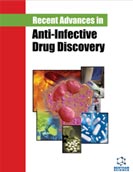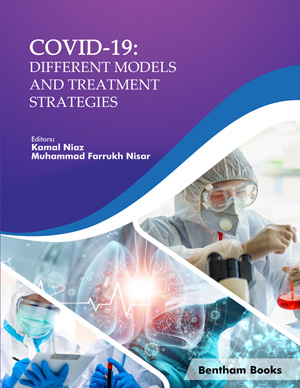Abstract
Pulegone ((R)-5-Methyl-2-(1-methylethylidine) cyclohexanone) is a pharmacologically active, natural monoterpene ketone obtained from leaves and flowering tops of the mint family (Lamiaceae). The aim is to comprise the physicochemical and biological aspects of pulegone. All significant databases were collected via electronic search using Pubmed, Scopus, Web of Science, and Science Direct and were compiled. This review presents the occurrence, chemistry, and modifications of pulegone structure and its effect on the biological system. Pulegone represents various pharmacological properties, i.e., antioxidant, antimicrobial, anti-feeding, antifungal, antiviral, and pesticide activities, and has a significant role as an abortifacient and emmenagogue. Thus, this present review concludes the knowledgeable erudition on pulegone that paves the way for further work.
Graphical Abstract
[http://dx.doi.org/10.1080/10412905.1995.9698544]
[http://dx.doi.org/10.1093/jee/87.6.1718]
[http://dx.doi.org/10.1142/3203]
[http://dx.doi.org/10.1016/S0040-4039(00)78070-1]
[http://dx.doi.org/10.1016/S0031-9422(97)01125-4] [PMID: 9747537]
[http://dx.doi.org/10.1186/1472-6882-6-39] [PMID: 17134518]
[http://dx.doi.org/10.1016/j.bbr.2006.05.006] [PMID: 16780969]
[http://dx.doi.org/10.1016/j.physbeh.2005.06.031] [PMID: 16095639]
[http://dx.doi.org/10.1093/ecam/neh087] [PMID: 15937558]
[http://dx.doi.org/10.1021/jf960685f]
[http://dx.doi.org/10.1002/jsfa.2740311104]
[http://dx.doi.org/10.1016/0031-9422(90)80012-6]
[http://dx.doi.org/10.1002/ffj.2730090307]
[http://dx.doi.org/10.1300/J044v07n01_07]
[http://dx.doi.org/10.1016/j.jphotobiol.2010.05.003] [PMID: 20627615]
[http://dx.doi.org/10.1021/jf60115a017]
[http://dx.doi.org/10.1021/jf60127a010]
[http://dx.doi.org/10.1104/pp.104.050229] [PMID: 15542490]
[http://dx.doi.org/10.1021/jf60201a021]
[PMID: 3252034]
[http://dx.doi.org/10.1093/toxsci/kfs135] [PMID: 22499580]
[http://dx.doi.org/10.1002/recl.19370560206]
[http://dx.doi.org/10.1021/jo00864a047]
[http://dx.doi.org/10.1016/S0040-4020(03)00936-0]
[http://dx.doi.org/10.1016/S0040-4039(01)81768-8]
[http://dx.doi.org/10.1016/0957-4166(95)00023-I]
[http://dx.doi.org/10.1016/S0040-4020(99)00636-5]
[http://dx.doi.org/10.1016/0957-4166(96)00190-5]
[http://dx.doi.org/10.1246/bcsj.46.1546]
[http://dx.doi.org/10.1039/P29720001601]
[http://dx.doi.org/10.1007/BF00664100]
[http://dx.doi.org/10.1016/1381-1169(96)00034-9]
[http://dx.doi.org/10.1016/S0040-4039(98)02060-7]
[http://dx.doi.org/10.1016/S1381-1169(99)00036-9]
[http://dx.doi.org/10.3891/acta.chem.scand.16-0640]
[http://dx.doi.org/10.1016/S0040-4039(00)00325-7]
[http://dx.doi.org/10.1021/jo991151r]
[http://dx.doi.org/10.1021/jo00162a025]
[http://dx.doi.org/10.1021/jo9517656]
[http://dx.doi.org/10.1021/jo00240a033]
[http://dx.doi.org/10.1002/hlca.19780610802]
[http://dx.doi.org/10.1016/S0278-6915(02)00230-2] [PMID: 12480305]
b) Herman A, Herman AP. Essential oils and their constituents as skin penetration enhancer for transdermal drug delivery: A review. J Pharm Pharmacol 2015; 67(4): 473-85.
[http://dx.doi.org/10.1111/jphp.12334] [PMID: 25557808]
[http://dx.doi.org/10.1016/j.jep.2006.07.022] [PMID: 16962274]
[http://dx.doi.org/10.1021/tx00011a013] [PMID: 2519826]
[http://dx.doi.org/10.1016/S0006-291X(05)80897-6] [PMID: 2268314]
[PMID: 10220485]
[PMID: 2891472]
[http://dx.doi.org/10.1016/S0261-2194(02)00095-9]
[http://dx.doi.org/10.1007/BF02662329]
[http://dx.doi.org/10.1046/j.1365-2621.2002.00552.x]
[http://dx.doi.org/10.1016/j.foodchem.2006.10.061]
[http://dx.doi.org/10.1016/S1011-1344(03)00024-1] [PMID: 12745247]
[http://dx.doi.org/10.1016/0378-8741(96)01406-7] [PMID: 8771455]
[http://dx.doi.org/10.1081/CLT-120021104] [PMID: 12807304]
[http://dx.doi.org/10.1016/S0378-8741(79)80014-8] [PMID: 232204]
[http://dx.doi.org/10.7326/0003-4819-124-8-199604150-00004] [PMID: 8633832]
[PMID: 4044323]
[http://dx.doi.org/10.1542/peds.98.5.944] [PMID: 8909490]
[http://dx.doi.org/10.1001/jama.1979.03300260043027] [PMID: 513258]
[http://dx.doi.org/10.1016/0378-4274(83)90120-0] [PMID: 6658833]





















